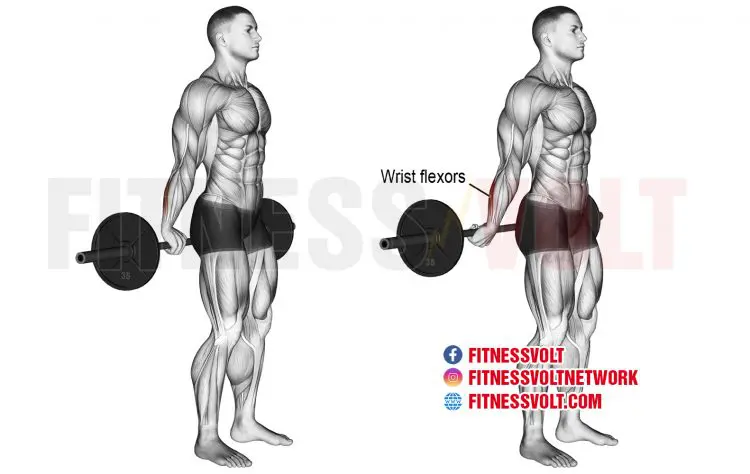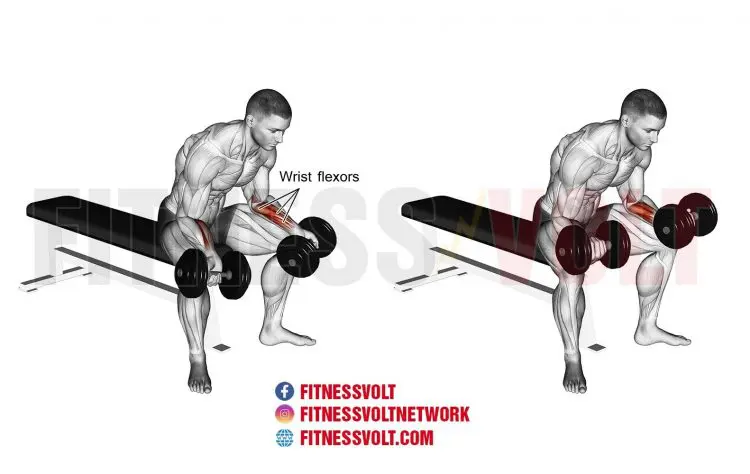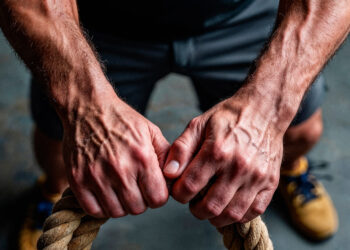The barbell wrist curl is a great isolation exercise for pumping up your forearms. Many exercisers neglect training the forearms directly because they’re heavily involved during pulling and curling movements. This is true. However, there are advantages to isolating them, and it’s not just for aesthetic purposes.
Training a muscle directly is also recommended for improving its strength and function. Strong and functional forearms improve grip which subsequently, improves performance.
Not to mention, the forearms are stubborn like the calves so if you are looking to gain a little muscle, doing wrist curls regularly could be just what you needed to start seeing more gains.
Here’s a guide to the barbell wrist curl…
Muscles Worked
- Wrist flexors
Wrist flexors are located on the palm side of the forearm and include several muscles that help us to curl the wrist.
How To Do The Barbell Wrist Curl
There are several different ways to do the barbell wrist curl. However, we’ve provided step-by-step instructions for the kneeling barbell variation.
Level Up Your Fitness: Join our 💪 strong community in Fitness Volt Newsletter. Get daily inspiration, expert-backed workouts, nutrition tips, the latest in strength sports, and the support you need to reach your goals. Subscribe for free!
- Grab a barbell using an underhand, shoulder-width, or narrower grip.
- Kneel down in front of the bench and place the top of your forearms on it so that your wrists are hanging off. Keep your back straight.
- With your elbows tucked in, curl your wrists upward and flex your forearms.
- Slowly lower the weight back down until you feel a stretch in your forearms but don’t allow the bar to roll down your fingers. Keep the bar deep in your hand.
- Repeat
Here’s a video example…
Barbell Wrist Curl Tips
- Never use maximal weights with the barbell wrist curl. This can place a lot of strain on your wrists and fingers.
- You can use a fixed or standard barbell.
- Light to moderate weight and higher reps (10-15) is optimal for this specific exercise.
- You can use a thumbless grip if it worse better for you.
- If you feel pain in your joints, do not continue.
3 Wrist Curl Variations
While the kneeling barbell wrist curl is a decent option for forearms training, it’s not the only one or even the best necessarily. That’s why we provided a few different variations as some people will like these better.
Standing barbell wrist curl
The standing barbell wrist curl may allow you to use more weight. It’s a great option for wrist curls and there are a few different ways to do it. You can hold the barbell behind your back with your palms facing away from you, or you can hold the barbell in front of your body with your knuckles facing away from you.
Dumbbell wrist curl
For some people, using a barbell is uncomfortable because the wrists are in a fixed position. Dumbbells offer more possibilities because they allow for free movement. So, you can actually rotate your wrists slightly inward to remove some stress from your wrists.
Dumbbells are also great for unilateral training which means you’re able to train your forearms separately. This allows you to identify and correct a weaker side.
Level Up Your Fitness: Join our 💪 strong community in Fitness Volt Newsletter. Get daily inspiration, expert-backed workouts, nutrition tips, the latest in strength sports, and the support you need to reach your goals. Subscribe for free!
You can do the dumbbell wrist curl similar to the above instructions but there are a few different options including the seated version, standing version, etc.
Cable wrist curl
Using a cable set up for wrist curls is going to offer the same benefits as using a barbell or dumbbell. But, the advantage of cables is that you can position your arms at a variety of angles because cables always keep tension on the muscles.
For example, if you wanted to do the behind-the-back cable wrist curl, you could walk farther forward so that your arms are extended behind your body. The tension will still be on the forearms. You can’t do this using free weights.
But if you wanted to do any wrist curl variation, you can do it with cables.
How To Incorporate The Barbell Wrist Curl Into Your Training Routine
The barbell wrist curl or any variation of the wrist curl makes for a great addition to any training routine. With that being said, there are a few different ways to fit it into your workouts.
Wrist curls make for a great finisher whether done after biceps curls, heavy back training, or after working any muscle group for that matter. The bulk of your forearm development will be from heavy compound exercises. So, heavy pulls and curls should be done before wrist curls. This isn’t a rule set in stone but it’s a common and effective way to structure your training.
Another way that you can include wrists curls in your training is to do them before biceps curls as a pre-exhaust method. The forearms are heavily involved in biceps curls which means the biceps may not receive as much stimulation as they could because the forearms are doing a lot of the curling.
If you train the forearm muscles before biceps curls, the biceps will be forced to take more of the load because the forearms are exhausted. That doesn’t mean that pre-exhausting the forearms is better than jumping right into curls.
But, as with any training technique, it can be a useful addition to your workouts.
Wrapping Up
The barbell wrist curl is preferred by many, and it’s a great exercise for building the forearms. However, the wrist curl can be done in a variety of ways, and so we recommend opting for the variation that is most comfortable, and that works best for you.
This doesn’t have to be a complex movement but just make sure that you do it right!
Interested in measuring your progress? Check out our strength standards for Wrist Curl, Dumbbell Wrist Curl.










